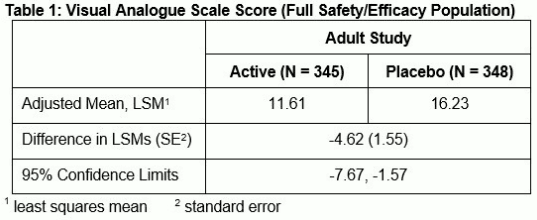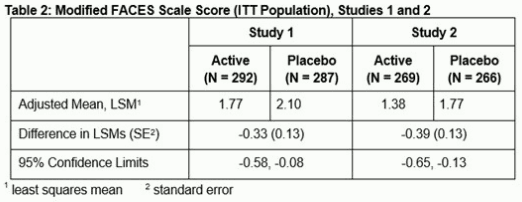ZINGO Powder intradermal injection Ref.[49663] Active ingredients: Lidocaine
Source: FDA, National Drug Code (US) Revision Year: 2018
12.1. Mechanism of Action
ZINGO delivers lidocaine hydrochloride monohydrate into the dermis. Lidocaine is an amide-type local anesthetic agent that blocks sodium ion channels required for the initiation and conduction of neuronal impulses, resulting in local anesthesia.
12.2. Pharmacodynamics
ZINGO provides local dermal analgesia within 1-3 minutes of application. Analgesia diminishes within 10 minutes of treatment.
12.3. Pharmacokinetics
Absorption
A single dose of ZINGO in adults did not produce detectable plasma concentrations of lidocaine (limit of quantitation 5 ng/mL) in any subject tested (n = 38).
Application of ZINGO to broken or inflamed skin, or multiple ZINGO applications, could result in systemic plasma levels of lidocaine that could produce systemic toxicity.
Distribution
When lidocaine is administered intravenously to healthy volunteers, the steady-state volume of distribution is approximately 0.8 to 1.3 L/kg. At much higher plasma concentrations (1 to 4 mcg/mL of free base) than those found following application of ZINGO, the plasma protein binding of lidocaine is concentration dependent. Lidocaine crosses the placental and blood brain barriers, presumably by passive diffusion. CNS toxicity may typically be observed around 5000 ng/mL of lidocaine; however a small number of patients reportedly may show signs of toxicity at approximately 1000 ng/mL.
Metabolism
It is not known if lidocaine is metabolized in the skin. Lidocaine is metabolized rapidly by the liver to a number of metabolites including monoethylglycinexylidide (MEGX) and glycinexylidide (GX), both of which have pharmacologic activity similar to, but less potent than that of lidocaine. The major metabolic pathway of lidocaine, sequential N-deethylation to monoethylglycinexylidide (MEGX) and glycinexylidide (GX), is primarily mediated by CYP1A2 with a minor role of CYP3A4. The metabolite, 2,6-xylidine, has unknown pharmacologic activity. Following intravenous administration of lidocaine, MEGX and GX concentrations in serum range from 11% to 36% and from 5% to 11% of lidocaine concentrations, respectively. Serum concentrations of MEGX are about one-third the serum lidocaine concentrations.
Elimination
The half-life of lidocaine elimination from the plasma following intravenous administration is approximately 1.8 hours. Lidocaine and its metabolites are excreted by the kidneys. More than 98% of an absorbed dose of lidocaine can be recovered in the urine as metabolites or parent drug. Less than 10% of lidocaine is excreted unchanged in adults, and approximately 20% is excreted unchanged in neonates. The systemic clearance is approximately 8-10 mL/min/kg. During intravenous studies, the elimination half-life of lidocaine was statistically significantly longer in elderly patients (2.5 hours) than in younger patients (1.5 hours).
13.1. Carcinogenesis, Mutagenesis, Impairment of Fertility
Carcinogenesis
Long-term studies in animals have not been performed to evaluate the carcinogenic potential of lidocaine.
Mutagenesis
No mutagenic potential of lidocaine was demonstrated in the in vitro Ames Bacterial Reverse Mutation Assay, the in vitro chromosome aberration assay using Chinese hamster ovary cells, and the in vivo mouse micronucleus assay.
Impairment of Fertility
ZINGO was not formally evaluated for effects on fertility. Significant systemic exposure to lidocaine is not expected under recommended conditions of use of ZINGO, as lidocaine levels were below the limit of detection in human studies. Lidocaine has been previously tested in animal studies for effects on fertility, however. The following ratios are based on the assumption that the applied dose is completely absorbed through the skin.
Lidocaine did not affect fertility in female rats when given via continuous subcutaneous infusion via osmotic minipumps up to doses of 250 mg/kg/day [1500 mg/m2 or 5000-fold higher than the SDA of 0.5 mg lidocaine in a 60 kg individual (0.3 mg/m2)]. Although lidocaine treatment of male rats increased the copulatory interval and led to a dose-related decreased homogenization resistant sperm head count, daily sperm production, and spermatogenic efficiency, the treatment did not affect overall fertility in male rats when given subcutaneous doses up to 60 mg/kg (360 mg/m2 or 1200-fold the SDA).
14. Clinical Studies
Efficacy in Adults
The efficacy of ZINGO in adults was evaluated in a randomized, double-blind, parallel-arm, sham-placebo controlled trial in which adult patients who required a venipuncture or peripheral venous cannulation received either ZINGO or a sham placebo device.
Patients were treated with ZINGO or a placebo device at the antecubital fossa or back of the hand, between one and three minutes prior to venipuncture or peripheral venous cannulation. Measurements of pain were made immediately following the procedure. Efficacy was measured using a continuous 100 mm visual analogue scale ranging from 0 (“no pain”) to 100 (“worst possible pain”).
Many of the patients had chronic medical problems such as depression, hypertension, hypothyroidism, and hyperlipidemia and over one fourth of the population may have been at higher than average risk of dermal bleeding due to use of concomitant medications such as NSAIDs, aspirin, and corticosteroids.
Treatment with active drug resulted in less pain compared with placebo (see Table 1).
However, efficacy was primarily seen in patients undergoing venipuncture at the antecubital fossa, while patients undergoing cannulation at the back of the hand did not demonstrate a difference between active and sham administrations.
Efficacy in Pediatric Patients
The efficacy of ZINGO in patients 3-18 years of age was evaluated in two randomized, double-blind, parallel-arm, sham-placebo controlled trials in which pediatric patients received either ZINGO or a sham placebo device.
The overall patient population consisted of healthy pediatric patients as well as those with acute and chronic medical conditions (i.e., diabetes, asthma, seizure disorder, juvenile rheumatoid arthritis and renal or hepatic transplantation) ages 3-18 years. All patients required peripheral venipuncture or intravenous cannulation as part of their clinical care.
Two efficacy trials (Studies 1 and 2) were conducted during which patients were treated with ZINGO or a placebo device at the back of hand or antecubital fossa, between one and three minutes prior to venipuncture or peripheral venous cannulation. Measurements of pain were made immediately following the venous procedure. Efficacy was measured using a modified version of the Wong-Baker FACES pain rating scale [a categorical 6-point scale containing 6 faces ranging from 0 (“no hurt”) to 5 (“hurts worst”)].
In both studies, treatment with active drug resulted in less pain, from venipuncture or peripheral IV cannulation, compared with placebo (See Table 2).
© All content on this website, including data entry, data processing, decision support tools, "RxReasoner" logo and graphics, is the intellectual property of RxReasoner and is protected by copyright laws. Unauthorized reproduction or distribution of any part of this content without explicit written permission from RxReasoner is strictly prohibited. Any third-party content used on this site is acknowledged and utilized under fair use principles.

